
Lee vs. Meade, subtitled "The Battle of Gettysburg", is a board wargame published by Rand Game Associates (RGA) in 1974 that simulates the Battle of Gettysburg during the American Civil War.

Lee vs. Meade, subtitled "The Battle of Gettysburg", is a board wargame published by Rand Game Associates (RGA) in 1974 that simulates the Battle of Gettysburg during the American Civil War.
Lee vs. Meade is a two-player grand tactical wargame in which one player takes the role of Confederate general Robert E. Lee, and the other takes the role of Union general George Meade.
The game box contains: [1]
The game uses an alternating "I Go, You Go" system, where the Confederate player moves and fires, then the Union player has the same opportunity. A complete turn represents one hour of game time. [2]
The map is divided into a 12 x 12 grid (144 squares). The movement costs to move from one square into the next (including diagonally) are marked on the map. [2]
When one unit moves into an opposing unit's square, the attacker chooses one of six TAC cards, and the defender does the same. [3] The two cards are cross-referenced on a chart; this and a die roll determines a combat result. [2]
There are five scenarios provided: the entire battle (41 turns); or four shorter scenarios representing a part of the overall battle. [3]
Both player accumulate victory points for eliminating enemy units, and for achieving certain geographical objectives. [3]

Rather than selling individual games in stores or via mail-order, RGA decided to sell a series of wargames via subscription. Players who subscribed to the series titled "Command Series, Volume I" received the first game as well as a large box with enough room to store the entire series of games. [3] A "Universal Command Series Package" was also included that contained a Universal Turn Recorder (a turn record track for up to 30 turns), TAC Cards (6 white cards and 6 red cards numbered from 1–6), and a six-sided die. [4] Subsequent games then arrived every six weeks. Lee vs. Meade was the first game in this subscription series, a wargame designed by David Isby, and published by RGA in 1974 packaged in an "LP album". In all, RGA would publish nine games in the series. [2]
Just after Lee vs. Meade was released, RGA made a deal with Gamut of Games, allowing the second company to sell the individual games in this series as separate boxed sets. Gamut of Games' edition of Lee vs. Meade was released in 1975. [2]
In Issue 28 of the UK magazine Games & Puzzles, John Humphries noted an issue with one of the scenarios: reinforcements brought on for the last turn can't reach the fighting in time. Humphries also found the game unbalanced in favor of the Union, saying, "for whilst he [the Union player] has a large number of weaker units, the Confederate has fewer, stronger ones, and may be forced to lose an eight for a two in any exchange, which is somewhat unrealistic." [3]
In the February 1976 edition of Airfix Magazine , Bruce Quarrie thought that both the combat matrix and the square grid map were "clever ideas." He concluded, "Lee Vs Meade is a well-made, fast-moving game ideal for newcomers to the field of conflict simulations." [5]
In a 1976 poll conducted by Simulations Publications Inc. to determine the most popular board wargames in North America, Lee vs. Meade placed a dismal 186th out of 202 games. [6] In his 1977 book The Comprehensive Guide to Board Wargaming , Nicholas Palmer expressed some surprise at the game's unpopularity, saying, "Low rating perhaps caused by the unfamiliar movement system, rated 195th for no very obvious reason." [6]
In Issue 17 of Moves (October–November 1974), Richard Berg was impressed by the game components, calling the counters "unquestionably the finest available, sturdy and handsome, with rounded edges for easy handling." But although he found the new movement system "interesting", he felt the game was a bit of a bore, saying it "has all the frantic action of the last hours of a 1925 dance marathon (zzzz)." Berg felt that "the overall strengths of the two sides are so equal that there is almost no incentive to combat [...] The result is a game where the balance is so 'good' that it is bad." He also felt the addition of a combat strategy matrix "only succeeds in adding a sham feeling of intricacy." Berg concluded, "In an effort to achieve simplicity the designer has designed all the strategic options out of the game, leaving the gamer with stereotyped, vapid playability. In light of the care put into the packaging and thought in design put into this game, the results are frustratingly banal." [2]

A wargame is a strategy game in which two or more players command opposing armed forces in a simulation of an armed conflict. Wargaming may be played for recreation, to train military officers in the art of strategic thinking, or to study the nature of potential conflicts. Many wargames re-create specific historic battles, and can cover either whole wars, or any campaigns, battles, or lower-level engagements within them. Many simulate land combat, but there are wargames for naval, air combat, and cyber as well as many that combine various domains.

Kingmaker is a board game published in the UK by PhilMar Ltd. in 1974 that simulates the political struggles to place a king on the throne of England during the Wars of the Roses. The game was popular, and other editions, including a computerized version, were produced by Avalon Hill, TM Games, and Gibsons Games. The game won a Charles S. Roberts Award in 1976.
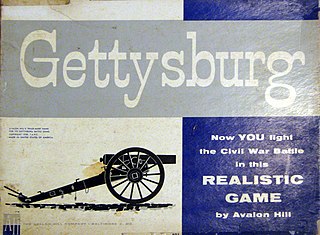
Gettysburg is a board wargame produced by Avalon Hill in 1958 that re-enacts the American Civil War battle of Gettysburg. The game rules were groundbreaking in several respects, and the game, revised several times, was a bestseller for Avalon Hill for several decades.
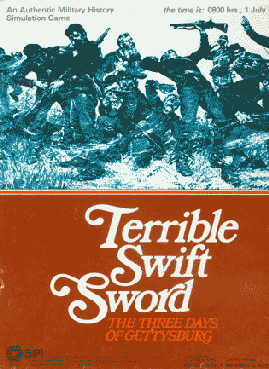
Terrible Swift Sword: Battle of Gettysburg Game is a grand tactical regimental level board wargame published by Simulations Publications, Inc. (SPI) in 1976 that simulates the Battle of Gettysburg during the American Civil War. A second edition was published by TSR in 1986.
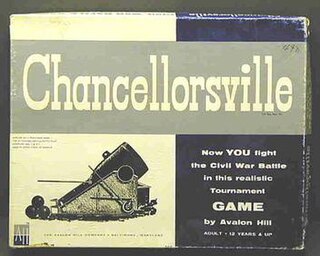
Chancellorsville is a board wargame produced by Avalon Hill in 1961, and republished in 1974 that simulates the Battle of Chancellorsville during the American Civil War.
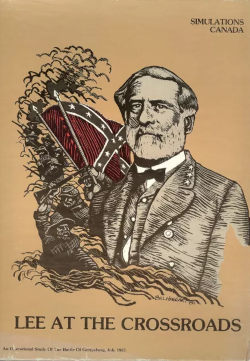
Lee at the Crossroads is a board wargame published by Simulations Canada (SimCan) in 1980 that simulates the 1863 Battle of Gettysburg during the American Civil War. Each player takes the role of one of the opposing commanders, Confederate general Robert E. Lee or Union general George Meade.

The American Civil War: 1861–1865 is a board wargame published by Simulations Publications Inc. (SPI) in 1974 that is a strategic simulation of the American Civil War.

Overlord, subtitled "The Normandy Invasion", is a board wargame published by Conflict Games in 1973 that simulates the Normandy landings and the subsequent attempt by the Germans to prevent the Allies from breaking out of Normandy during World War II.

Lee Moves North, originally titled Lee at Gettysburg and subtitled "The Confederate Summer Offensive, 1862 & 1863", is a board wargame published by Simulations Publications Inc. (SPI) in 1972 that simulates Robert E. Lee's summer offenses of 1862 and 1863 during the American Civil War

MechWar '77, subtitled "Tactical Armored Combat in the 1970s", is a board wargame published by Simulations Publications Inc. (SPI) in 1975 that simulates hypothetical tank combat in the mid-1970s between various adversaries, using the same rules system as the previously published Panzer '44.

Frigate: Sea War in the Age of Sail is a board wargame published by Simulations Publications Inc. (SPI) in 1974 that simulates naval combat in the 18th and 19th century Age of Sail.
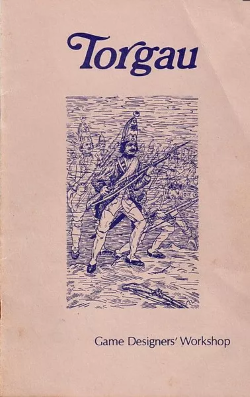
Torgau is a board wargame published by Game Designers' Workshop (GDW) in 1974 that simulates the Battle of Torgau between Prussias and Austrians in 1760 during the Seven Years' War, a costly battle for both sides. Reviews were generally favorable, although gameplay was characterized as very long, complex, and more similar to traditional miniatures wargaming than board wargames.

Invasion: Sicily – Alexander vs Kesselring is a board wargame published by Rand Game Associates in 1974 that simulates the Allied invasion of Sicily during World War II.
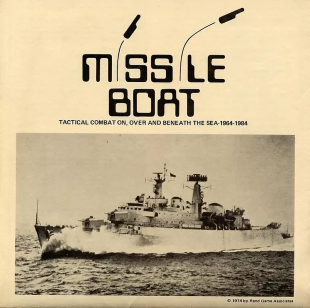
Missile Boat, subtitled "Tactical Combat On, Over and Beneath the Sea 1964-1984", is a board game published by Rand Game Associates (RGA) in 1974 that simulates naval combat using ships and weaponry from the mid-1960s to the mid-1980s.

Napoleon's Last Campaigns is a board wargame published by Rand Game Associates (RGA) in 1974 that simulates the final campaigns of Napoleon in 1814 and 1815.

Battle of the Wilderness: Gaining the Initiative, May 5-6, 1864 is a board wargame published by Simulations Publications, Inc. (SPI) in 1975 that simulates the Battle of the Wilderness during the American Civil War. The game was originally part of the four-game collection Blue & Gray II, and was also released as a stand-alone "folio" game.
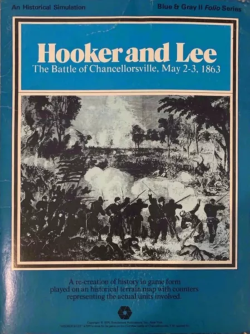
Hooker and Lee, subtitled "The Battle of Chancellorsville, May 2-3, 1863, Nov. 24-25, 1863" is a board wargame published by Simulations Publications, Inc. (SPI) in 1975 that simulates the Battle of Chancellorsville during the American Civil War. The game was originally part of the four-game collection Blue & Gray II, and was also released as a stand-alone "folio" game.
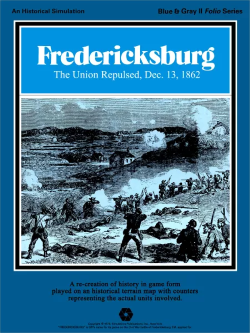
Fredericksburg: The Union Repulsed is a board wargame published by Simulations Publications, Inc. (SPI) in 1975 that simulates the Battle of Fredericksburg during the American Civil War. The game was originally part of the four-game collection Blue & Gray II, and was also released as a stand-alone "folio" game.

Saratoga 1777, subtitled "Burgoyne vs Gates", is a board wargame published by Rand Game Associates (RGA) in 1974 that simulates the Battle of Saratoga during the American Revolutionary War. At the time, this was the only board wargame based on that battle.

Omaha Beach is a board wargame published by Rand Game Associates (RGA) in 1974 that simulates the American landings on Omaha Beach as part of the D-Day landings during World War II.